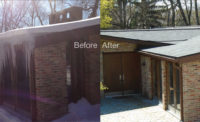Three Innovations Revolutionizing Roofing Restoration
Making Equipment Work for You










Roofing is admittedly sort of the odd-man-out of the restoration industry. Some companies offer it; others do not.
In 2012, wind and hail alone caused nearly $4 billion in property damage across the U.S., with Texas taking the top slot. According to the Rocky Mountain Insurance Information Association, in 2013 there were 5,457 major hail storms. In 2014, there were 5,536 major events. While property damage costs fluctuate from year-to-year, hail damage is as inevitable as a flood in some parts of the U.S.
In July of 2013, David Dybdahl penned an article for Restoration & Remediation on how roofing could be a viable opportunity for increased revenue for restoration companies. Looks like he was right! Check out his fresh take on this topic in this Roofing Restoration Special Section! Now, a plethora of products and new technologies are pushing the restoration roofing industry forward by helping contractors become more efficient, tidier, and safer. Here’s a look at just a fewof the industry’s latest innovations.
Keep it Clean
How many times have you driven past a home getting a new roof, and seen shingles littered around on the ground as the workers yank them from the roof and toss them below? One company, Equipter, is literally taking roofing jobs to new heights. The self-propelled, lightweight machines are able to be driven across lawns without leaving ruts, and raise up to the roof level to allow garbage to be tossed into it, then driven right over to an on-site dumpster. No more spending hours picking up scraps and splinters from yards and flower beds.
Brothers Aaron and Toby Nelson own Nelson Contracting, LLC. While specializing in storm restoration, they also offer everything from roofing and siding to gutters. They believe in investing in equipment that will help them exceed customers’ expectations time after time. So sure, buying a product that makes cleanup quicker and more efficient makes sense.
“I don’t have guys hurting all the time because they had to haul 4,000 pounds of shingles four times throughout the day,” Aaron Nelson said. “What Equipter has allowed us to do is really kind of streamline all of our processes so that we don’t need 15 guys to get a lot of work done.”
Nelson said in four days, one of his six-man crews was able to complete five roofs. Since adding Equipter to their roofing “tool kit,” Nelson Contracting has upped their closing ratios from 30-35 percent to 50-60 percent, and seen referrals increase from 50 percent to 80 percent.
Build an Effective Tool Kit
Have you ever gone into a job thinking, “Gosh, I wish there was a tool for _____”? Joe Skach, president of Artillery Tools, spent the last 12 years inventing, reinventing, and improving the basic pry bar into a multi-use, multi-function tool with nearly endless possibilities.
While working for a sheet metal company more than a decade ago, Skach was handed the job of tearing siding off several buildings at a school complex. Just three weeks into the year-long job, and frustrated by inefficiency of improper tools, Skach went to a local machine shop and create something himself.
“It worked really well. I had three different handle lengths right off the bat, so I was up on a ladder with a 36 inch bar going two times further in every direction tearing the siding off, and not having to move a 40 foot ladder as often, and it was raining siding,” Skach reminisced about the inception of what would become Artillery Tools. “No one had ever seen anything like that. From there on, it was add another blade, change the fulcrum shape, change the handles, and make a case.”
In the last few years, Skach set his eyes on the restoration industry with the invention of his Disaster Restoration Set.
“It has five additional pieces on top of the contractor set,” Skach said. “It gives them about 60 different tools. I’ve got nine different blades, and in less than a minute you can take a blade and switch it so you have the best tool.”
With all the reconfigurations, a kit could be used for roofing, flooring, siding, concrete, and pretty much any other material you may need to pry up.
Prevent Further Damage
Covering a damaged roof with a tarp is a tough, labor-intensive job often requiring several workers, rolls of material, sandbags and hours of work. It was out of the need for a better solution that UTARPit was born. It’s affectionately called “a giant bandaid.”
Patented just four years ago, the popularity of the product is picking up speed, and 90 percent of the company’s current clients are restoration contractors.
The self-adhesive roof tarps are meant to sustain winds up to 110 miles per hour, and nearly nine inches of rain an hour without coming off. The company also says it can be installed by one person in as little as 15 minutes. Plus, there’s no nailing required – a process that can cause further damage to roofs.
“Now, I can send one tech and an easy-to-use UTARPit product, and have the roof tarped within minutes upon arrival,” says Kevin White, president of Gulf Coast Restoration and Construction. “The self-adhesive tarp is easy to use, saves time, and money. Not to mention, the non-destructive application does not damage roof materials.”
By covering a roof sooner, contractors may be able to prevent further damage to a home during a severe storm or other event.
Sharing the “Wealth”
Restoration & Remediation is always excited to learn about new products working their way into the industry, and pass along that “wealth” of knowledge to you. Keep up on the latest innovations and technologies big and small on www.randrmagonline.com
Looking for a reprint of this article?
From high-res PDFs to custom plaques, order your copy today!












